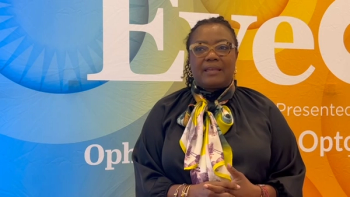
MIGS and Trab: Peaceful co-existence
While articles and discussions on minimally invasive glaucoma surgery (MIGS) seem to be everywhere (for better or worse), “trabeculectomy will survive,” said Kuldev Singh, MD, because of the aging population, the ease of postoperative titration, and the need for even lower pressures.
The glaucoma device market is expected to grow at three to four times the rate of the refractive and cataract surgery and the IOL markets over the next few years, Dr. Singh said.
Dr. Singh’s presentation was part of the 23rd Annual Glaucoma Symposium at the 2019 Glaucoma 360 meeting. Dr. Singh is professor of ophthalmology and director of the Glaucoma Service, Stanford University School of Medicine, Palo Alto, CA. “We currently have 17 distinct procedures for glaucoma inflow/outflow procedures,” Dr. Singh pointed out. “We have non-device MIGS procedures, and we have lasers that reduce aqueous production.”
All of these procedures are leading to a “Glaucoma Restoration” period, likening the current state of glaucoma to a “Glaucoma Renaissance.”
“Not all these procedures and devices will survive,” he said. “There will always be a role for trabeculectomy as a result.”
Trabeculectomy: Post-renaissance:
In the new era, there may even be a greater need for trabeculectomy than there is now, Dr. Singh said. Among his predictions:
- The entire MIGS segment will continue to grow. The procedures “have really revolutionized how we care for patients with mild-to-moderate disease,” Dr. Singh said. “We offer a non-pharmaceutical option for these patients and that category will continue to grow.”
- Trabeculectomy will continue to be relevant, especially when MIGS fail, or when patients have more severe disease or are older and need lower pressures. “From a numbers standpoint, there are going to be more people who need tra-beculectomy 10 or 15 years from now than there ever have been,” he added.
But will there be people out there who know how to perform the surgery? “That’s a different issue,” Dr. Singh said.
12 mm Hg outdated?
The “ideal” intraocular pressure (IOP) level is continually decreasing-from 21 mm Hg, to 18 mm Hg, then to 12 mm Hg.
“Most people don’t need 12 mm Hg,” Dr. Singh said. “But there’s a small subset in whom 12 mm Hg is not enough-they need 6 mm Hg. Six will be the new 12.”
He added that procedures, such as MIGS, won’t be able to achieve those lower levels for people with much worse disease.
There will always be two types of glaucoma patients, Dr. Singh said-those who continually do well regardless of treatment, and those who continually fare poorly, regardless of treatment.
“We have to know our patients,” Dr. Singh outlined. “The treatment can't be worse than disease. And fortunately, there are many more with mild disease and low risk for progression than high risk for progression.”
MIGS and drops will continue to be the norm for “Glaucoma Lite,” Dr. Singh said.
Preferred trab technique
But for that subset of patients who progress fast and have catastrophic outcomes, treatment needs to be aggressive. The aging population means it is likely glaucoma specialists are going to be seeing greater numbers of patients who fall into that category.
“As patients age, they start to lose optic nerve tissue from the aging process,” Dr. Singh said. “Glaucoma becomes difficult to treat in patients with IOPs of 10 mm Hg to 15 mm Hg in their 80s and 90s who may be going downhill very fast.”
Be aggressive in aiming for lower pressures, he advised, adding that only trabeculectomy achieves that. Dr. Singh recommends using lower dose mitomycin over a broader area, resulting in more diffuse, minimally vascular blebs.
Dr. Singh’s preferred trabeculectomy technique includes making a limbus-based flap in the majority of his patients (about 85%), but notes in Asian patients, he may prefer fornix-based procedure. A limbus-based procedure allows surgeons “to cut sutures early in the postoperative period without worrying about leaks,” he added.
While Dr. Singh acknowledges trabeculectomies are more work than other procedures, having an assistant to hold the conjunctiva or providing more exposure “makes limbus-based trabeculectomy a lot easier.”
Trab postop care
Trabeculectomies done properly “require a lot of postoperative work, a lot of care.” Dr. Singh believes releasable suture lysis is as important as antifibrotics, because that will allow surgeons “to titrate pressure postoperatively,” he explained. “Those two together have made trabeculectomy a unique procedure.
“We can perform the surgery and postoperatively aim for whatever IOP you think is best, based on how you release sutures,” he added. “None of the newer procedures offers that. That’s one of the real advantages of this type of approach.”
Dr. Singh also advised that when performing the newer procedures, “Don't ruin the superior conjunctiva. Most likely, these patients are going to need a trabeculectomy if they have bad disease,” he said.
“I like procedures in the canal and in the eye that don’t adversely impact the conjunctiva,” he said. “I have had patients who underwent some of these newer procedures and now have to go straight to a tube because there is not enough healthy conjunctiva at 12 o’clock to perform a trabeculectomy.”
Finally, Dr. Singh aims to see wound closure at the time of surgery and will inflate the bleb.
“Most of these patients will have double-digit IOPs in the early postoperative period,” he said. “I don't like to see early hypotony-you want to quiet the eye down and remove stitches one to two weeks out rather than right away. The eye will do much better.”
Newsletter
Don’t miss out—get Ophthalmology Times updates on the latest clinical advancements and expert interviews, straight to your inbox.



















































.png)


